Advances in All-Solid-State Passively Q-Switched Lasers Based on Cr4+:YAG Saturable Absorber
Abstract
1. Introduction
2. Research Progress
2.1. Nd3+-Doped Passively Q-Switched Lasers
2.1.1. Research Progress on Passively Q-Switched Lasers in the Infrared Band
2.1.2. Passively Q-Switched Green Lasers
2.1.3. Passively Q-Switched Raman Lasers
2.1.4. Passively Q-Switched Vortex Lasers
2.2. Yb3+-Doped Passively Q-Switched Lasers
2.3. Brief Summary
3. Summary and Outlook
Author Contributions
Funding
Institutional Review Board Statement
Informed Consent Statement
Data Availability Statement
Conflicts of Interest
References
- Ma, J.; Dong, J. Advances in Passively Q-Switched Yb3+-Doped Laser Materials Microchip Solid-State Lasers. Chin. J. Lasers 2010, 37, 2278–2288. [Google Scholar]
- Li, M.L.; Meng, P.B.; Yan, F.J.; Shi, W.Z.; Feng, W.; Luo, P.P. Research progress of high repetition frequency passively Q-switched solid-state lasers. LOP 2015, 52, 7–16. [Google Scholar]
- Yang, C.W.; Chen, Q.S.; Xiong, K.; Yin, X.D.; Huo, Y.J. Recent Developments on Cr4+: YAG Passively Q-switched Lasers. Laser Infrared 2003, 1, 21–24. [Google Scholar]
- Kellner, T.; Heine, F.; Huber, G.; Kück, S. Passive Q Switching of a Diode-Pumped 946-nm Nd: YAG Laser with 1.6-W Average Output Power. Appl. Opt. 1998, 37, 30. [Google Scholar] [CrossRef] [PubMed]
- Andrauskas, D.M.; Kennedy, C. Tetravalent Chromium Solid-State Passive Q Switch for Nd: YAG Laser Systems. In Proceedings of the Advanced Solid State Lasers, Hilton Head, SC, USA, 18–20 March 1991. [Google Scholar]
- Zayhowski, J.J.; Dill, C. Diode-pumped passively Q-switched picosecond microchip lasers. Opt. Lett. 1994, 19, 1427–1429. [Google Scholar] [CrossRef]
- Mallard, J.; Guillot, D. Up to 350 microJoules with a microchip laser at 1064 nm. In Proceedings of the Conference on Lasers and Electro-Optics Europe, Nice, France, 10–15 September 2000. [Google Scholar]
- Pavel, N.; Saikawa, J.; Kurimura, S.; Shoji, I.; Taira, T. Intra-cavity frequency doubling of a Nd: YAG laser passively Q-switched by Cr4+: YAG saturable absorber. In Proceedings of the Conference on Lasers and Electro-Optics, Baltimore, MD, USA, 11 May 2001. [Google Scholar]
- Forget, S.; Druon, F.; Balembois, F.; Georges, P.; Landru, N.; Fève, J.P.; Lin, J.L.; Weng, Z.M. Passively Q-switched diode-pumped Cr4+: YAG/Nd3+: GdVO4 monolithic microchip laser. Opt. Commun. 2006, 259, 816–819. [Google Scholar] [CrossRef]
- Tsunekane, M.; Taira, T. High peak power, passively Q-switched Yb: YAG/Cr: YAG micro-lasers. IEEE J. Quantum Electron. 2013, 49, 454–461. [Google Scholar] [CrossRef]
- Bezotosnyi, V.V.; Gorbunkov, M.V.; Koromyslov, A.L.; Pevtsov, V.F.; Popov, Y.M.; Tunkin, V.G.; Cheshev, E.A. Dual-wavelength generation at the transverse mode locking in a diode-end-pumped passively Q-switched Nd: YLF/Cr4+: YAG laser. Bull. Lebedev Phys. Inst. 2017, 44, 1–4. [Google Scholar] [CrossRef]
- Brandus, C.A.; Greculeasa, M.; Broasca, A.; Voicu, F.; Gheorghe, L.; Pavel, N. Diode-pumped bifunctional Nd: LGSB laser passively Q-switched by a Cr4+: YAG saturable absorber. Opt. Mater. Express 2021, 11, 685–694. [Google Scholar] [CrossRef]
- Wang, X.L.; Wang, X.J.; Dong, J. Sub-nanosecond, high peak power Yb: YAG/Cr4+: YAG/YVO4 passively Q-switched Raman micro-laser operating at 1134 nm. J. Lumin. 2021, 234, 117955. [Google Scholar] [CrossRef]
- Tsai, S.Y.; Chiu, C.P.; Chang, K.C.; Wei, M.D. Periodic and chaotic dynamics in a passively Q-switched Nd: GdVO4 laser with azimuthal polarization. Opt. Lett. 2016, 41, 1054–1057. [Google Scholar] [CrossRef]
- Srivastava, D.K.; Agarwal, A.K. Comparative experimental evaluation of performance, combustion and emissions of laser ignition with conventional spark plug in a compressed natural gas fuelled single cylinder engine. Fuel 2014, 123, 113–122. [Google Scholar] [CrossRef]
- Agarwal, A.K.; Singh, A.P.; Pal, A. Effect of laser parameters and compression ratio on particulate emissions from a laser ignited hydrogen engine. Int. J. Hydrogen Energy 2017, 42, 10622–10635. [Google Scholar] [CrossRef]
- Dascalu, T.; Croitoru, G.; Grigore, O.; Pavel, N. High-peak-power passively Q-switched Nd: YAG/Cr4+: YAG composite laser with multiple-beam output. Photonics Res. 2016, 4, 267–271. [Google Scholar] [CrossRef]
- Pavel, N.; Tsunekane, M.; Kanehara, K.; Taira, T. Composite all-ceramics, passively Q-switched Nd: YAG/Cr4+: YAG monolithic micro-laser with two-beam output for multi-point ignition. In Proceedings of the Laser Science to Photonic Applications, Baltimore, MD, USA, 1–6 May 2011. [Google Scholar]
- Ma, Y.F.; He, Y.; Yu, X.; Li, X.D.; Li, J.; Yan, R.P.; Peng, J.B.; Zhang, X.L.; Sun, R.; Pan, Y.B.; et al. Multiple-beam, pulse-burst, passively Q-switched ceramic Nd: YAG laser under micro-lens array pumping. Opt. Express 2015, 23, 24955–24961. [Google Scholar] [CrossRef]
- Lim, H.H.; Taira, T. High peak power Nd: YAG/Cr: YAG ceramic microchip laser with unstable resonator. Opt. Express 2019, 27, 31307–31315. [Google Scholar] [CrossRef] [PubMed]
- Tsunekane, M.; Inohara, T.; Ando, A.; Kido, N.; Kanehara, K.; Taira, T. High Peak Power, Passively Q-switched Microlaser for Ignition of Engines. IEEE J. Quantum Electron. 2010, 46, 277–284. [Google Scholar] [CrossRef]
- Patane, P.; Nandgaonkar, M. Review: Multipoint laser ignition system and its applications to IC engines. Opt. Laser Technol. 2020, 130, 106305. [Google Scholar] [CrossRef]
- Dong, J.; Bai, S.C.; Liu, S.H.; Ueda, K.I.; Kaminskii, A.A. A high repetition rate passively Q-switched microchip laser for controllable transverse laser modes. J. Opt. 2016, 18, 055205. [Google Scholar] [CrossRef]
- He, H.S.; Zhang, M.M.; Dong, J.; Ueda, K.I. Linearly polarized pumped passively Q-switched Nd: YVO4 microchip laser for Ince–Gaussian laser modes with controllable orientations. J. Opt. 2016, 18, 125202. [Google Scholar] [CrossRef]
- Dong, J.; He, Y.; Bai, S.C.; Ueda, K.I.; Kaminskii, A.A. A Cr4+: YAG passively Q-switched Nd: YVO4 microchip laser for controllable high-order Hermite–Gaussian modes. Laser Phys. 2016, 26, 095004. [Google Scholar] [CrossRef]
- Zhang, M.M.; Bai, S.C.; Dong, J. Effects of Cr4+ ions on forming Ince–Gaussian modes in passively Q-switched microchip solid-state lasers. Laser Phys. Lett. 2019, 16, 025003. [Google Scholar] [CrossRef]
- Ma, Y.F.; Peng, Z.F.; Peng, F.; Ding, S.J.; He, Y.; Yu, X.; Zhang, Q.L.; Li, L.J. A diode-pumped Cr4+: YAG passively Q-switched Nd: GdTaO4 laser. Opt. Laser Technol. 2018, 108, 202–206. [Google Scholar] [CrossRef]
- Lan, J.L.; Huang, X.X.; Guan, X.F.; Xu, B.; Xu, H.Y.; Cai, Z.P.; Xu, X.D.; Li, D.Z.; Xu, J. Laser characteristics of Nd3+-doped calcium barium niobate ferroelectric crystal at 1.06 and 1.34 μm. Appl. Opt. 2017, 56, 4191–4196. [Google Scholar] [CrossRef] [PubMed]
- Xu, X.D.; Di, J.Q.; Zhang, J.; Tang, D.Y.; Xu, J. CW and passively Q-switched laser performance of Nd: Lu2SiO5 crystal. Opt. Mater. 2016, 51, 241–244. [Google Scholar] [CrossRef]
- Cui, Q.; Zhou, Z.Y.; Guan, X.F.; Xu, B.; Lin, Z.; Xu, H.Y.; Cai, Z.P.; Xu, X.D.; Li, D.Z.; Xu, J. Diode-pumped continuous-wave and passively Q-switched Nd: LuAG crystal lasers at 1.1 μm. Opt. Laser Technol. 2017, 96, 190–195. [Google Scholar] [CrossRef]
- Liang, H.C.; Li, D.; Lin, E.H.; Hsu, C.C.; Lin, H.Y. Investigation of the antiphase dynamics of the orthogonally polarized passively Q-switched Nd: YLF laser. Opt. Express 2018, 26, 26590–26597. [Google Scholar] [CrossRef]
- Lin, H.Y.; Liu, H.; Chen, Q.; Huang, X.H.; Sun, D. Passively Q-switched Nd: GSGG laser at 936.3 nm. Optik 2020, 211, 164642. [Google Scholar] [CrossRef]
- Zhang, Y.Y.; Li, J.R.; Hu, Y.Y.; Zhang, H.D.; Qiu, C.C.; Zhang, C.; Wang, X.P.; Liu, B.; Yang, Y.G.; Lv, X.S. Temperature tunable lasers with disordered Nd:ABC3O7 crystals. Opt. Laser Technol. 2020, 125, 106018. [Google Scholar] [CrossRef]
- Ma, Y.F.; Peng, Z.F.; He, Y.; Yao, W.M.; Yan, R.P.; Li, X.D.; Yu, X.; Peng, F.; Zhang, Q.L.; Dou, R.Q. Continuous-wave and passively Q-switched Nd: GYTO4 laser. Laser Phys. Lett. 2017, 14, 095802. [Google Scholar] [CrossRef]
- Ma, Y.F.; Sun, H.Y.; Peng, Z.F.; Ding, S.J.; Peng, F.; Yu, X.; Zhang, Q.L. Diode-pumped continuous-wave and passively Q-switched Nd: GdLaNbO4 laser. Opt. Mater. Express 2018, 8, 983–991. [Google Scholar] [CrossRef]
- Zong, M.Y.; Zhang, Z.M.; Feng, X.Y.; Zhao, M.F.; Liu, J.; Xu, X.D. Efficient continuous-wave and passively Q-switched lasers based on disordered Nd: Ca0.7La0. 3Al12O19 crystals. Opt. Laser Technol. 2020, 125, 106022. [Google Scholar] [CrossRef]
- Li, Y.B.; Feng, C.; Jia, Z.T.; Zhang, J.; Tao, X.T. Crystal growth, spectra and passively Q-switched laser at 1106 nm of Nd: Gd3AlGa4O12 crystal. J. Alloy Compd. 2020, 814, 152248. [Google Scholar] [CrossRef]
- Lu, H.D.; Mangaiyarkarasi, D. Thermal focal length determination of a laser crystal by modulating the pump source. Laser Phys. 2020, 30, 066205. [Google Scholar] [CrossRef]
- Naegele, M.; Stoppel, K.; Ridderbusch, H.; Dekorsy, T. Passively Q-switched Nd: YVO4 laser operating at 914 nm. In Proceedings of the SPIE LASE, San Francisco, CA, USA, 21 February 2020. [Google Scholar]
- LI, C.Y.; Dong, J. Pump beam waist-dependent pulse energy generation in Nd: YAG/Cr4+: YAG passively Q-switched microchip laser. J. Mod. Opt. 2016, 63, 1323–1330. [Google Scholar] [CrossRef]
- Xing, E.B.; Rong, J.M.; Khew, S.Y.; Tong, C.Z.; Hong, M.H. Thermal lens effect for optimizing a passively Q-switched 1064 nm laser. Appl. Phys. Express 2018, 11, 062702. [Google Scholar] [CrossRef]
- Koromyslov, A.L.; Tupitsyn, I.M.; Cheshev, E.A. Experimental study of cavity length influence on lasing characteristics Q-Switched Nd: YLF laser. JPCS 2020, 1439, 012022. [Google Scholar]
- Zhang, B.C.; Chen, Y.; Wang, P.Y.; Wang, Y.C.; Liu, J.B.; Hu, S.; Xia, X.S.; Sang, Y.B.; Yuan, H.; Cai, X.L. Direct bleaching of a Cr4+: YAG saturable absorber in a passively Q-switched Nd: YAG laser. Appl. Opt. 2018, 57, 4595–4600. [Google Scholar] [CrossRef]
- Fan, Y.M.; Zah, C.E.; Wu, D.H.; Gao, C.; Li, Y.; Liu, X.S. Diode pumped passively Q-switched Nd: YAG/Cr: YAG solid-state lasers with a stable output of millijoules at 1064 nm over a wide temperature range. In Proceedings of the SPIE LASE, San Francisco, CA, USA, 21 February 2020. [Google Scholar]
- Song, J.; Li, C.; Ueda, K.I. Thermal influence of saturable absorber in passively Q-switched diode-pumped cw Nd: YAG/Cr4+: YAG laser. Opt. Commun. 2000, 177, 307–316. [Google Scholar] [CrossRef]
- Yin, S.M.; Wu, Y.; Sun, N.C. Influence of temperature on Cr4+: YAG passively Q-switched laser plateau region. Opt. Optoelect. Technol. 2010, 8, 31–34. [Google Scholar]
- Ma, Y.F.; Li, H.J.; Lin, J.P.; Yu, X. A thermally-insensitive passively Q-switched Cr4+: YAG/Nd: YAG laser. Opt. Laser Technol. 2011, 43, 1491–1494. [Google Scholar] [CrossRef]
- Nie, M.M.; Liu, Q.; Ji, E.C.; Gong, M.L. End-pumped temperature-dependent passively Q-switched lasers. Appl. Opt. 2015, 54, 8383–8387. [Google Scholar] [CrossRef]
- Xue, J.W.; Shi, J.Q.; Chen, W.; Pan, Y.; Su, B.H. Temperature dependence of a Cr4+: YAG passively Q-switched single-longitudinal-mode Nd: YVO4 ring cavity laser. Optik 2017, 130, 769–776. [Google Scholar] [CrossRef]
- Zheng, L.H.; Kausas, A.; Taira, T. > MW peak power at 266 nm, low jitter kHz repetition rate from intense pumped microlaser. Opt. Express 2016, 24, 28748–28760. [Google Scholar] [CrossRef]
- Chen, S.Y.; Yang, H.L.; Wang, M.J.; Zhang, X.; Jiang, J.; Meng, J.Q.; Chen, W.B. Analysis of Natural Longitudinal Mode Selection in Passively Q-Switched Lasers. Chin. J. Lasers 2016, 43, 0801006. [Google Scholar] [CrossRef]
- Croitoru, G.; Grigore, O.V.; Dinca, M.; Pavel, N.; Bärwinkel, M.; Heinz, P.; Brüggemann, D. Aspects of Air-Breakdown with a High-Peak Power Passively Q-Switched Nd: YAG/Cr4+: YAG Laser. In Proceedings of the Laser Ignition Conference, Bucharest, Romania, 20–23 June 2017. [Google Scholar]
- Villafana, R.E.; Chiu, R.; Mora, G.M.; Casillas, R.F.; Medel, R.C.; Sevilla, E.R. Dynamics of a Q-switched Nd: YVO4/Cr: YAG laser under periodic modulation. Results Phys. 2019, 12, 908–913. [Google Scholar] [CrossRef]
- Bai, J.R.; Liu, Y.; Zhong, Z.Y.; Meng, J.; Shi, J.J.; Wang, M.J.; Meng, J.Q.; Hou, X.; Chen, W.B. Narrow Pulse Width lasers Operating over Wide Range of Low Temperature. Chin. J. Lasers 2019, 46, 0101004. [Google Scholar]
- Li, X.D.; Zhou, Y.P.; Yan, R.P.; Wang, D.Y.; Fa, X.; Ma, Y.F.; Zhou, Z.X. A compact pulse burst laser with YAG/Nd: YAG/Cr4+: YAG composite crystal. Optik 2017, 136, 107–111. [Google Scholar] [CrossRef]
- Yan, R.P.; Li, X.D.; Zhang, Y.B.; Liu, Z.X.; Wen, X.L.; Chen, D.Y.; Zhou, Z.X. High-repetition-rate, high-peak-power burst mode laser with YAG/Nd: YAG/Cr4+: YAG composite crystal. Optik 2018, 175, 263–267. [Google Scholar] [CrossRef]
- Huang, X.S.; Hui, Y.L.; Jiang, M.H.; Lei, H.; Li, Q. Passively Q-switched Nd: YAG/Cr4+: YAG micro laser with high beam quality. In Proceedings of the International Symposium on Optoelectronic Technology and Application 2016, Beijing, China, 9–11 May 2016. [Google Scholar]
- Xue, J.W.; Pan, Y.; Chen, W.; Fang, Y.J.; Xie, H.J.; Xie, M.Y.; Sun, L.; Su, B.H. Cr: YAG passively Q-switched single-frequency Nd: YVO4 ring cavity laser. JOSA B 2016, 33, 1815–1819. [Google Scholar]
- Xue, F.; Zhang, S.S.; Cong, Z.H.; Huang, Q.J.; Guan, C.; Wu, Q.W.; Chen, H.; Bai, F.; Liu, Z.J. Diode-end-pumped single-longitudinal-mode passively Q-switched Nd: GGG laser. Laser Phys. Lett. 2018, 15, 035001. [Google Scholar] [CrossRef]
- Negri, J.R.; Pirzio, F.; Agnesi, A. Passively Q-switched single-frequency Nd: YVO4 ring laser with external feedback. Opt. Express 2018, 26, 11903–11908. [Google Scholar] [CrossRef] [PubMed]
- Negri, J.R.; Pirzio, F.; Agnesi, A. Jitter investigation of narrow-bandwidth passively Q-switched Nd: YAG unidirectional ring laser. Opt. Lett. 2019, 44, 3094–3097. [Google Scholar] [CrossRef] [PubMed]
- Chen, T.; Chen, X.; Zhou, C.L.; Li, M.; Shu, R. Single-longitudinal-mode-operated, passively Q-switched Nd: YAG/Cr4+: YAG microchip laser with 100 kHz repetition rate and 400 ps pulse width. Appl. Opt. 2020, 59, 4191–4197. [Google Scholar] [CrossRef] [PubMed]
- Wang, J.X.; Zhang, W.Z.; Wang, Q.Y.; Xing, Q.R.; Deng, P.Z.; Xu, J.; Qiao, Z.W. Passive Mode-Locking in a CPM Nd: YAG Laser Using Cr4+: YAG. Acta Opt. Sin. 1998, 18, 24–28. [Google Scholar]
- Chen, Y.F.; Tsai, S.; Wang, S.C. High-power diode-pumped Q-switched and mode-locked Nd: YVO4 laser with a Cr4+: YAG saturable absorber. Opt. Lett. 2000, 25, 1442–1444. [Google Scholar] [CrossRef]
- Zhang, S.J.; Wu, E.; Zeng, H.P. Q-switched mode-locking by Cr4+: YAG in a laser-diode-pumped c-cut Nd: GdVO4 laser. Opt. Commun. 2004, 231, 365–369. [Google Scholar] [CrossRef]
- Ng, S.P.; Tang, D.Y.; Kong, J.; Qin, L.J.; Meng, X.L.; Xiong, Z.J. Q-switched and continuous-wave mode-locking of a diode-pumped Nd: Gd0.64Y0.36VO4−Cr4+: YAG laser. Appl. Phys. B 2005, 81, 511–515. [Google Scholar] [CrossRef]
- Tian, W.; Wang, C.; Wang, G.; Liu, S.; Liu, J. Performance of diode-pumped passively Q-switched mode-locking Nd: GdVO4/KTP green laser with Cr4+: YAG. Laser Phys. Lett. 2006, 4, 196. [Google Scholar] [CrossRef]
- Liu, F.Q.; He, J.L.; Xu, J.L.; Zhang, B.T.; Yang, J.F.; Xu, J.Q.; Gao, C.Y.; Zhang, H.J. Passively Q-switched mode-locking in a diode-pumped c-cut Nd: LuVO4 laser with Cr4+: YAG. Laser Phys. Lett. 2009, 6, 567. [Google Scholar] [CrossRef]
- Jelínek, M. Functional planar thin film optical waveguide lasers. Laser Phys. Lett. 2011, 9, 91–99. [Google Scholar] [CrossRef]
- Beach, R.J.; Mitchell, S.C.; Meissner, H.E.; Meissner, O.R.; Krupke, W.F.; McMahon, J.M.; Bennett, W.J.; Shepherd, D.P. Continuous-wave and passively Q-switched cladding-pumped planar waveguide lasers. Opt. Lett. 2001, 26, 881–883. [Google Scholar] [CrossRef] [PubMed]
- Mackenzie, J.I. Dielectric solid-state planar waveguide lasers: A review. IEEE J. Sel. Top. Quantum Electron. 2007, 13, 626–637. [Google Scholar] [CrossRef]
- Zhou, H.Q.; Zhu, S.Q.; Jiang, W.; Li, Z.; Wang, Y.C.; Yin, H.; Chen, Z.Q.; Yuan, J. Diode-end-pumped passively Q-switched blue laser with Nd: YAG/YAG/Cr4+: YAG/YAG composite crystal. Optik 2016, 127, 10588–10592. [Google Scholar] [CrossRef]
- Zhang, X.Z.; Zhou, Y.; Yasukevich, A.; Loiko, P.; Mateos, X.; Xu, X.G.; Guo, S.Y.; Wang, Z.P. Diode-pumped passively Q-switched self-frequency-doubled Nd: CNGS laser. Opt. Express 2017, 25, 19760–19766. [Google Scholar] [CrossRef]
- Zhou, Y.; Wang, Z.P.; Chen, F.F.; Yu, F.P.; Xu, X.G. 1 kW Peak Power Self-Frequency-Doubling Microchip Laser. IEEE Photonics J. 2019, 11, 1–5. [Google Scholar] [CrossRef]
- Wang, X.J.; Wang, X.L.; Zheng, Z.F.; Qiao, X.H.; Dong, J. 1164.4 nm and 1174.7 nm dual-wavelength Nd: GdVO4/Cr4+: YAG/YVO4 passively Q-switched Raman microchip laser. Appl. Opt. 2018, 57, 3198–3204. [Google Scholar] [CrossRef]
- Duan, Y.M.; Zhang, J.; Zhu, H.Y.; Zhang, Y.C.; Xu, C.W.; Wang, H.Y.; Fan, D.Y. Compact passively Q-switched RbTiOPO4 cascaded Raman operation. Opt. Lett. 2018, 43, 4550–4553. [Google Scholar] [CrossRef] [PubMed]
- Jiang, C.; Chen, Y.Y.; Mei, S.H.; Zhu, S.Q.; Li, Z.; Jiang, W.; Zhou, H.Q.; Chen, Z.Q.; Ji, E.C. Investigation of a passively Q-switched Raman laser at 1176 nm with Nd3+: YAG/Cr4+: YAG/YAG composite crystal and a coupled cavity. Opt. Quantum Electron. 2019, 51, 380. [Google Scholar] [CrossRef]
- Lin, H.Y.; Pan, X.; Huang, X.H.; Xiao, M.; Liu, X.; Sun, D.; Zhu, W.Z. Multi-wavelength passively Q-switched c-cut Nd: YVO4 self-Raman laser with Cr4+: YAG saturable absorber. Opt. Commun. 2016, 368, 39–42. [Google Scholar] [CrossRef]
- Lin, H.Y.; Pan, X.; Huang, X.H.; Xiao, M.; Liu, X.; Sun, D.; Zhu, W.Z. Cr4+: YAG passively Q-switched c-cut Nd: YVO4 self-Raman laser at 1168.6 nm. Infrared Phys. Technol. 2016, 75, 56–58. [Google Scholar] [CrossRef]
- Chen, M.T.; Dai, S.B.; Zhu, S.Q.; Yin, H.; Li, Z.; Chen, Z.Q. Multi-watt passively Q-switched self-Raman laser based on a c-cut Nd: YVO4 composite crystal. J. Opt. Soc. Am. B 2019, 36, 524–532. [Google Scholar] [CrossRef]
- Li, S.T.; Jin, G.Y.; Dong, Y. Simultaneous three Raman shift passively Q-switched intracavity Raman laser based on the overlapping Raman shift of 259 cm−1 in c-cut GdVO4 and YVO4. Appl. Phys. B 2020, 126, 37. [Google Scholar] [CrossRef]
- Chen, Y.F.; Chang, C.C.; Lee, C.Y.; Sung, C.L.; Tung, J.C.; Su, K.W.; Liang, H.C.; Chen, W.D.; Zhang, G. High-peak-power large-angular-momentum beams generated from passively Q-switched geometric modes with astigmatic transformation. Photonics Res. 2017, 5, 561–566. [Google Scholar] [CrossRef]
- Tuan, P.H.; Liang, H.C.; Huang, K.F.; Chen, Y.F. Realizing high-pulse-energy large-angular-momentum beams by astigmatic transformation of geometric modes in an Nd: YAG/Cr4+: YAG laser. IEEE J. Sel. Top. Quantum Electron. 2018, 24, 1–9. [Google Scholar] [CrossRef]
- Pan, Y.; Zhang, M.M.; Dong, J. Orientation and separation controllable dual-vortex passively Q-switched microchip laser. J. Opt. 2019, 21, 085202. [Google Scholar] [CrossRef]
- Fan, T.Y. Heat generation in Nd: YAG and Yb: YAG. IEEE J. Quantum Electron. 1993, 29, 1457–1459. [Google Scholar] [CrossRef]
- Ertel, K.; Banerjee, S.; Mason, P.D.; Phillips, P.J.; Siebold, M.; Hernandez, G.C.; Collier, J.C. Optimising the efficiency of pulsed diode pumped Yb: YAG laser amplifiers for ns pulse generation. Opt. Express 2011, 19, 26610–26626. [Google Scholar] [CrossRef] [PubMed]
- Li, Q.Q.; Chen, X.Z.; Fan, S.G. Study on the preparation and properties of Yb: YAG glass ceramics. J. Synth. Cryst. 2010, 39, 163–168. [Google Scholar]
- Šulc, J.; Eisenschreiber, J.; Jelínková, H.; Nejezchleb, K.; Škoda, V. Influence of temperature on Yb: YAG/Cr: YAG microchip laser operation. In Proceedings of the SPIE LASE, San Francisco, CA, USA, 17 February 2017. [Google Scholar]
- Šulc, J.; Eisenschreiber, J.; Němec, M.; Jelínková, H.; Nejezchleb, K.; Škoda, V. Temperature and Pumping Beam Radius Influence on Yb: YAG/Cr: YAG Microchip Laser Output. In Proceedings of the CLEO/Europe-EQEC, Munich, Germany, 23–27 June 2019. [Google Scholar]
- Rodenko, O.; Tidemand, L.P.; Pedersen, C. Low repetition rate 343 nm passively Q-switched solid-state laser for time-resolved fluorescence spectroscopy. Opt. Express 2018, 26, 20614–20621. [Google Scholar] [CrossRef]
- Kim, J.; Moon, S.; Park, Y.; Kim, H.S. Optimization of a Passively Q-switched Yb: YAG Laser Ignitor Pumped by a Laser Diode with Low Power and Long Pulse Width. Curr. Opt. Photonics 2020, 4, 127–133. [Google Scholar]
- Guo, X.Y.; Tokita, S.; Kawanaka, J. 12 mJ Yb: YAG/Cr: YAG microchip laser. Opt. Lett. 2018, 43, 459–461. [Google Scholar] [CrossRef] [PubMed]
- Li, J.Z.; Chen, Z.Q.; Zhu, S.Q. High-peak-power and short-pulse laser with a Yb: YAG/Cr4+: YAG/YAG composite crystal. Infrared Laser Eng. 2018, 47, 606007-0606007. [Google Scholar]
- Li, J.Z.; Zhu, S.Q. High-peak-power short-pulse laser using a Yb: YAG/Cr4+: YAG/YAG composite crystal. Optik 2019, 176, 630–635. [Google Scholar] [CrossRef]
- Mackenzie, J.I.; Shepherd, D.P. End-pumped, passively Q-switched Yb: YAG double-clad waveguide laser. Opt. Lett. 2002, 27, 2161–2163. [Google Scholar] [CrossRef] [PubMed]
- Lei, H.; Liu, Q.; Wang, Y.; Hui, Y.L.; Zhu, Z.D.; Li, Q. Passively Q-switched pulse laser with large core size crystal waveguide near diffraction-limit beam quality output. Acta Opt. Sin. 2021, 41, 1214001. [Google Scholar]
- Ye, P.P.; Zhu, S.Q.; Li, Z.; Yin, H.; Zhang, P.X.; Fu, S.H.; Chen, Z.Q. Passively Q-switched dual-wavelength green laser with an Yb: YAG/Cr4+: YAG/YAG composite crystal. Opt. Express 2017, 25, 5179–5185. [Google Scholar] [CrossRef] [PubMed]
- Wang, X.L.; Wang, X.J.; Dong, J. Multi-wavelength, Sub-Nanosecond Yb: YAG/Cr4+: YAG/YVO4 Passively Q-Switched Raman Microchip Laser. IEEE J. Sel. Top. Quantum Electron. 2018, 24, 1–8. [Google Scholar]
- Mougel, F.; Dardenne, K.; Aka, G.; Kahn-Harari, A.; Vivien, D. Ytterbium-doped Ca4GdO(BO3)3: An efficient infrared laser and self-frequency doubling crystal. J. Opt. Soc. Am. B 1999, 16, 164–172. [Google Scholar] [CrossRef]
- David, S.P.; Jambunathan, V.; Yue, F.X.; Le Garrec, B.J.; Lucianetti, A.; Mocek, T. Laser performances of diode pumped Yb: Lu2O3 transparent ceramic at cryogenic temperatures. Opt. Mater. Express 2019, 9, 4669–4676. [Google Scholar] [CrossRef]
- Liu, J.H.; Wang, L.S.; Han, W.J.; Xu, H.H.; Zhong, D.G.; Teng, B. Plate-shaped Yb: LuPO4 crystal for efficient CW and passively Q-switched microchip lasers. Opt. Mater. 2016, 60, 114–118. [Google Scholar] [CrossRef]
- Schoepp, T.R.; Tiedje, H.F.; Fedosejevs, R. Characterisation and Modelling of a Passively Q-Switched Yb: CaF2 Laser. IEEE J. Quantum Electron. 2017, 53, 1–8. [Google Scholar] [CrossRef]
- Serres, J.M.; Loiko, P.A.; Mateos, X.; Liu, J.H.; Zhang, H.J.; Yumashev, K.; Griebner, U.; Petrov, V.; Aguiló, M.; Díaz, F. Multi-watt passively Q-switched Yb: YAB/Cr: YAG microchip lasers. In Proceedings of the SPIE LASE, San Francisco, CA, USA, 17 February 2017. [Google Scholar]
- Liu, Q.Y.; Yuan, H.L.; Dai, X.J.; Zhang, Y.; Zhao, Y.G.; Xu, H.H.; Pan, Z.B. Efficient pulsed laser operation of Yb-doped Gd3Sc2Ga3O12 mixed crystal. Opt. Eng. 2018, 57, 096103. [Google Scholar] [CrossRef]
- David, S.P.; Jambunathan, V.; Yue, F.X.; Lucianetti, A.; Mocek, T. Efficient diode pumped Yb: Y2O3 cryogenic laser. Appl. Phys. B 2019, 125, 137. [Google Scholar] [CrossRef]
- Li, Y.H.; Xu, Y.F.; Dong, L.; Han, W.J.; Xu, H.H.; Liu, J.H. Passively Q-switched laser action of Yb: LaCa4O(BO3)3 crystal. Laser Phys. 2019, 29, 085801. [Google Scholar] [CrossRef]
- Dun, Y.Y.; Li, P.; Chen, X.H.; Ma, B.M. High-power passively Q-switched Nd: YAG laser at 1112 nm with a Cr4+: YAG saturable absorber. Chin. Phys. Lett. 2016, 33, 024201. [Google Scholar]
- Maleki, A.; Saghafifar, H.; Tehrani, M.K.; Soltanolkotabi, M.; Baghi, M.D.; Ardestani, M.M. 57ámJ with 10áns passively Q-switched diode pumped Nd: YAG laser using Cr4+: YAG crystal. Opt. Quantum Electron. 2016, 48, 48. [Google Scholar] [CrossRef]
- Lee, H.C.; Chang, D.W.; Lee, E.J.; Yoon, H.W. High-energy, sub-nanosecond linearly polarized passively Q-switched MOPA laser system. Opt. Laser Technol. 2017, 95, 81–85. [Google Scholar] [CrossRef]
- Zhou, Y.; Jiao, M.X.; Lian, T.H.; Xing, J.H.; Liu, Y.; Liu, J.N. Design and Experimental Investigation of Passively Q-Switched Two-Cavity Dual-Frequency Nd: YAG Laser. Chin. J. Lasers 2018, 45, 1201008. [Google Scholar] [CrossRef]
- Koromyslov, A.L.; Tupitsyn, I.M.; Cheshev, E.A. Dual-wavelength Q-switched laser based on a lens-shaped Nd: YAG active element and a Cr4+: YAG passive Q-switch. Quantum Electron. 2019, 49, 95. [Google Scholar] [CrossRef]
- Liu, Y.; Yan, R.P.; Wu, W.T.; Li, X.D.; Dong, Z.; Liu, Z.X.; Wen, X.L.; Yao, W.M.; Peng, F.; Zhang, Q.L. High-repetition-rate passively Q-switched Nd: GdTaO4 1066 nm laser under 879 nm pumping. Infrared Phys. Technol. 2019, 102, 103025. [Google Scholar] [CrossRef]
- Lin, H.Y.; Huang, X.H.; Liu, H. Passively Q-switched Nd: YAG laser at 1074.1 nm. Optik 2020, 207, 163831. [Google Scholar] [CrossRef]
- Loiko, P.; Serres, J.M.; Mateos, X.; Yumashev, K.; Yasukevich, A.; Petrov, V.; Griebner, U.; Aguiló, M.; Díaz, F. Sub-nanosecond Yb: KLu (WO4)2 microchip laser. Opt. Lett. 2016, 41, 2620–2623. [Google Scholar] [CrossRef]
- Wang, L.S.; Han, W.J.; Xu, H.H.; Zhong, D.G.; Teng, B.; Liu, J.H. Passively Q-switched oscillation at 1005–1012 nm of a miniature Yb: LuPO4 crystal rod laser. Laser Phys. Lett. 2017, 14, 045807. [Google Scholar] [CrossRef]
- Navratil, P.; Jambunathan, V.; David, S.P.; Yue, F.X.; Serres, J.M.; Mateos, X.; Aguiló, M.; Díaz, F.; Griebner, U.; Petrov, V. Continuous-wave and passively Q-switched cryogenic Yb: KLu(WO4)2 laser. Opt. Express 2017, 25, 25886–25893. [Google Scholar] [CrossRef] [PubMed]
- Dou, X.D.; Yang, J.N.; Ma, Y.J.; Han, W.J.; Xu, H.H.; Liu, J.H. Passive Q-switching of a Yb: LuVO4 laser with Cr4+: YAG: Approaching the intrinsic upper limit of repetition rate. Chin. Phys. Lett. 2018, 35, 064201. [Google Scholar] [CrossRef]
- Tian, K.; Dou, X.D.; Yi, H.Y.; Han, W.J.; Xu, H.H.; Liu, J.H. Anomalous passive Q-switching induced by Cr4+: YAG: With pulse repetition rate approaching up to 1 MHz. Laser Phys. 2018, 29, 015805. [Google Scholar] [CrossRef]
- Bourdon, P.; Planchat, C.; Fleury, D.; Le, G.J.; Gustave, F.; Dolfi, B.A.; Lombard, L.; Durecu, A.; Jacqmin, H. Passively cooled Cr: YAG Q-switched Yb: YAG micro-laser delivering continuously tunable high repetition rate bursts of short pulses. In Proceedings of the SPIE LASE, San Francisco, CA, USA, 7 March 2019. [Google Scholar]
- McIntosh, C.; Hays, A.; Chinn, S.; Goldberg, L.; Leach, J. High average power passively Q-switched Yb: YAG micro-laser. In Proceedings of the SPIE LASE, San Francisco, CA, USA, 21 February 2020. [Google Scholar]
- Tanaka, H.; Kariyama, R.; Iijima, K.; Hirosawa, K.; Kannari, F. Saturation of 640-nm absorption in Cr4+: YAG for an InGaN laser diode pumped passively Q-switched Pr3+: YLF laser. Opt. Express 2015, 23, 19382–19395. [Google Scholar] [CrossRef]
- Tanaka, H.; Kariyama, R.; Iijima, K.; Kannari, F. 50-kHz, 50-ns UV pulse generation by diode-pumped frequency doubling Pr3+: YLF Q-switch laser with a Cr4+: YAG saturable absorber. Appl. Opt. 2016, 55, 6193–6198. [Google Scholar] [CrossRef]
- He, Y.; Ma, Y.F.; Li, J.; Li, X.D.; Yan, R.P.; Gao, J.; Yu, X.; Sun, R.; Pan, Y.B. Continuous-wave and passively Q-switched 1.06 μm ceramic Nd: YAG laser. Opt. Laser Technol. 2016, 81, 46–49. [Google Scholar] [CrossRef]
- Ma, Y.F.; He, Y.; Peng, Z.F.; Yan, R.P.; Li, X.D.; Yu, X.; Tong, Y.; Ge, L.; Li, J.; Tittel, F.K. Doubly Q-switched tape casting YAG/Nd: YAG/YAG ceramic laser. J. Mod. Opt. 2018, 65, 1549–1553. [Google Scholar] [CrossRef]
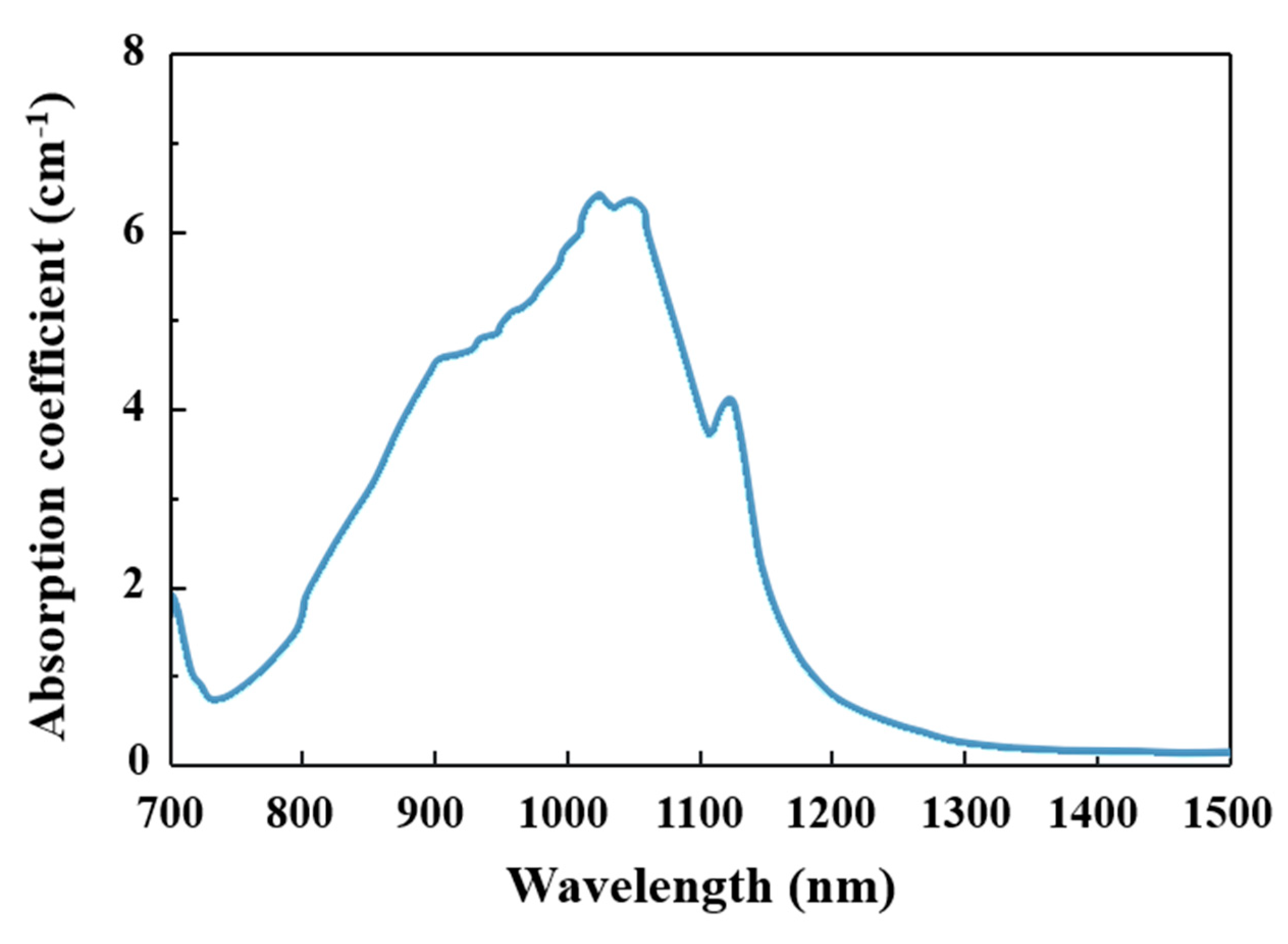
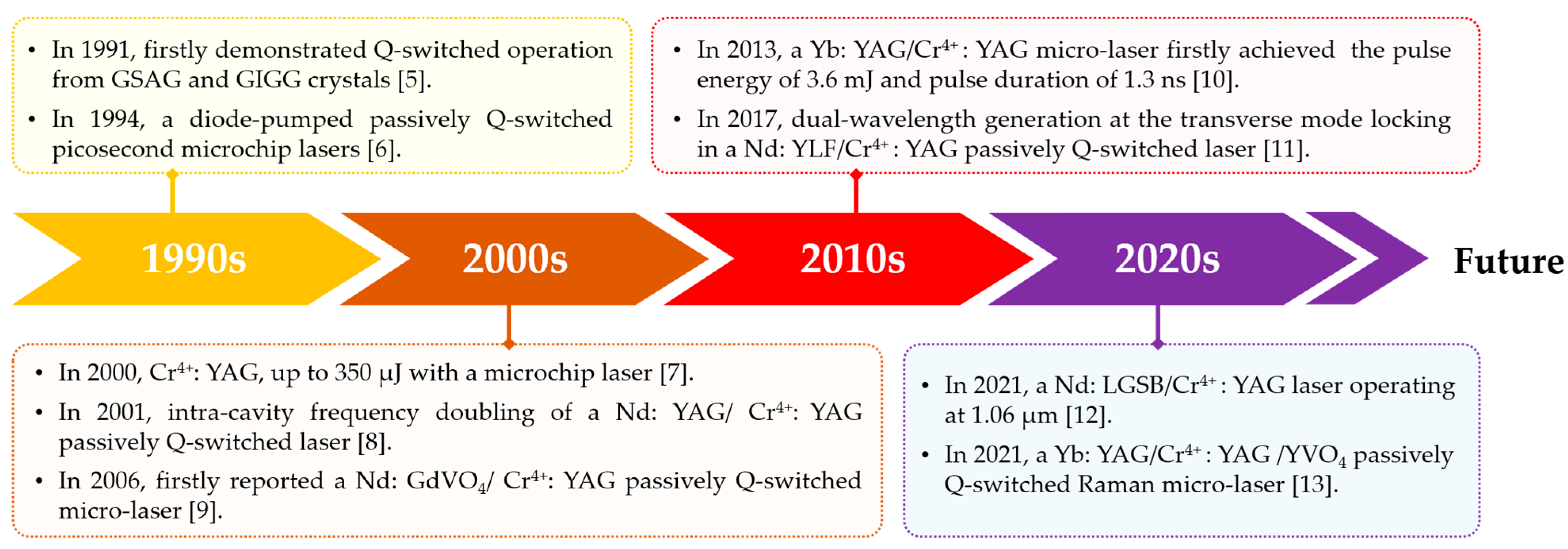


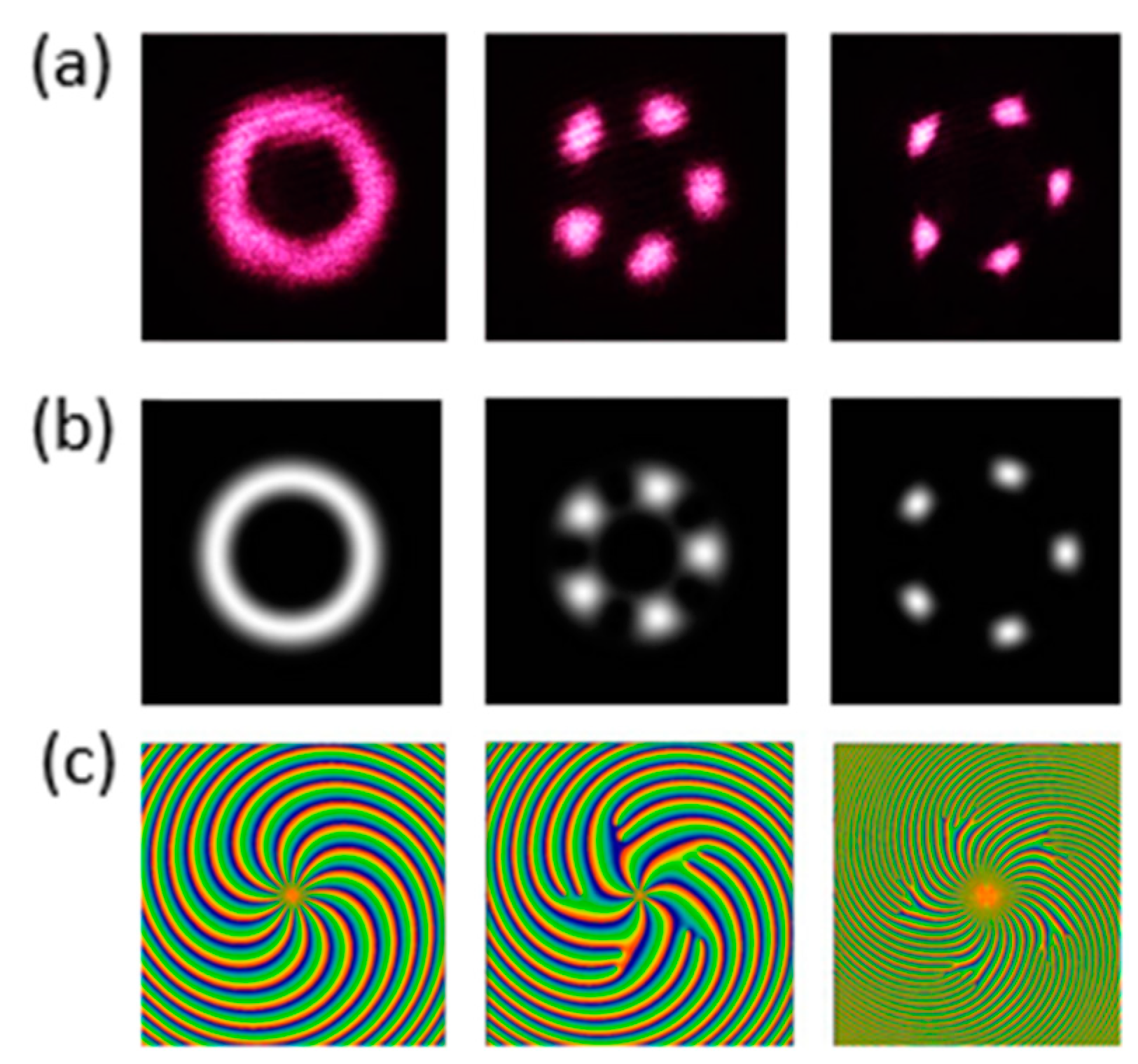
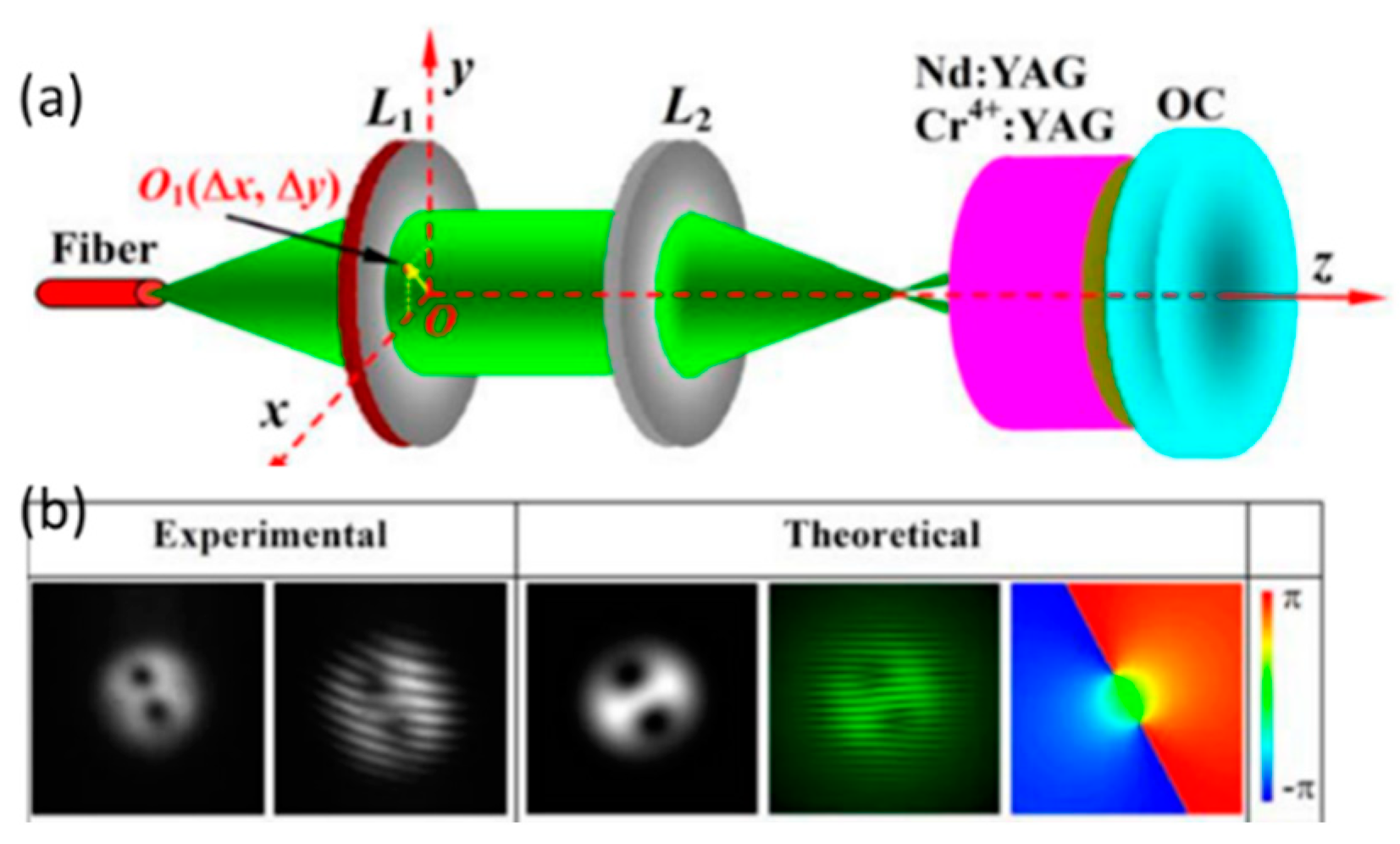
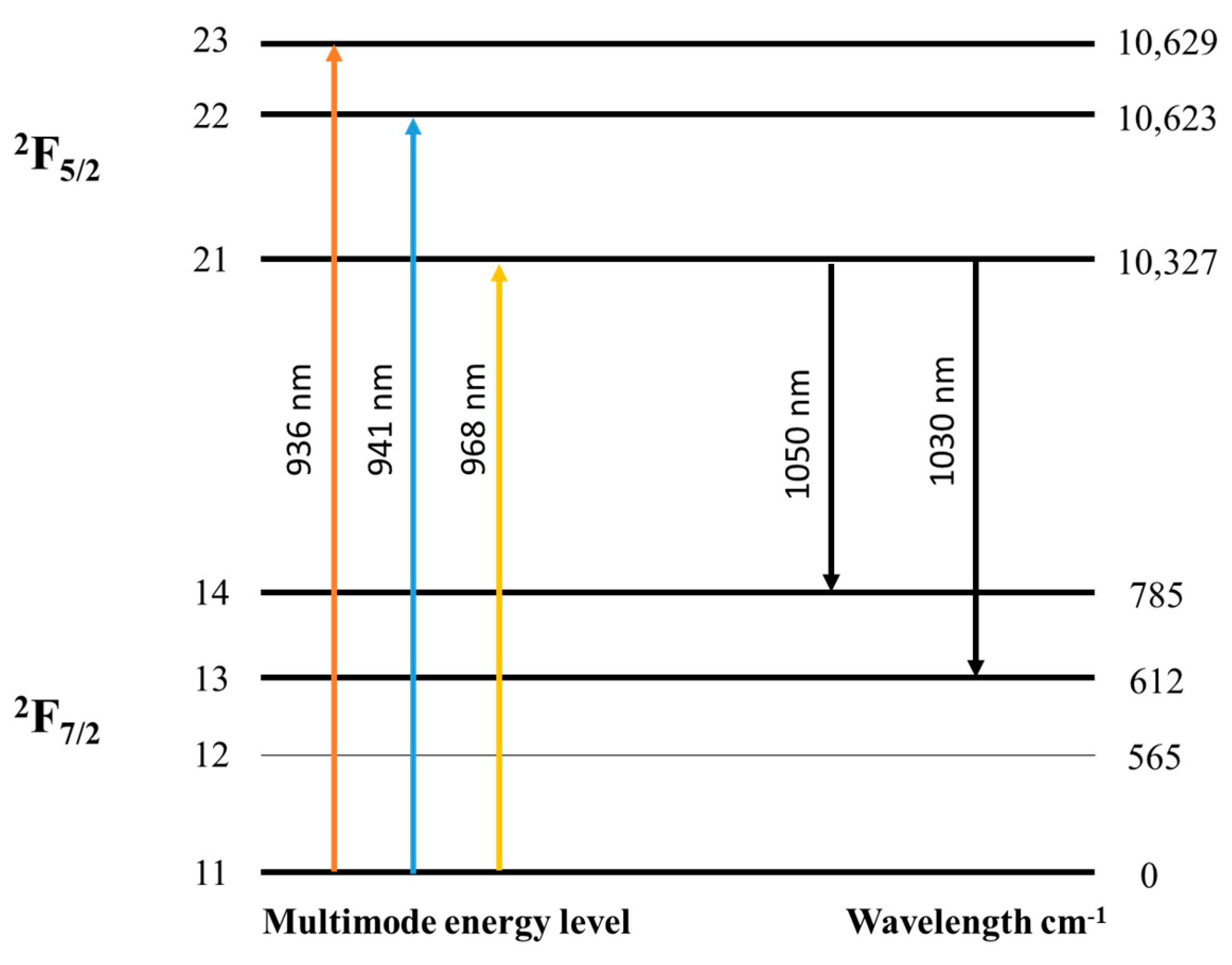
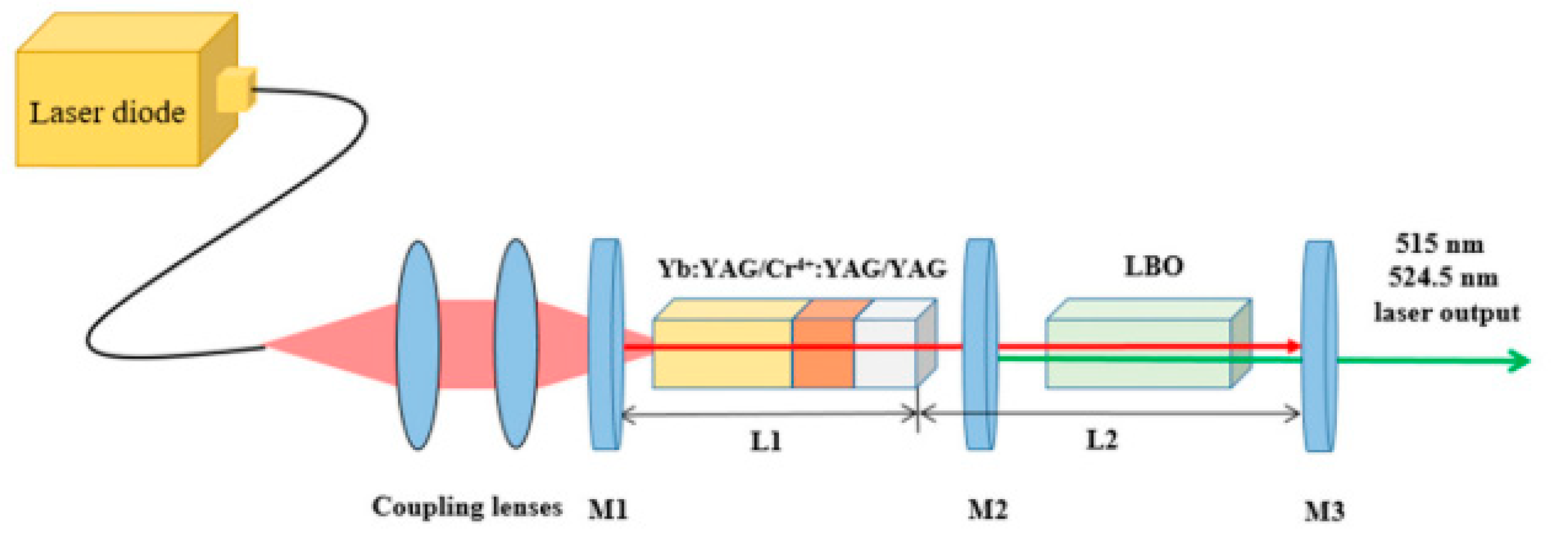
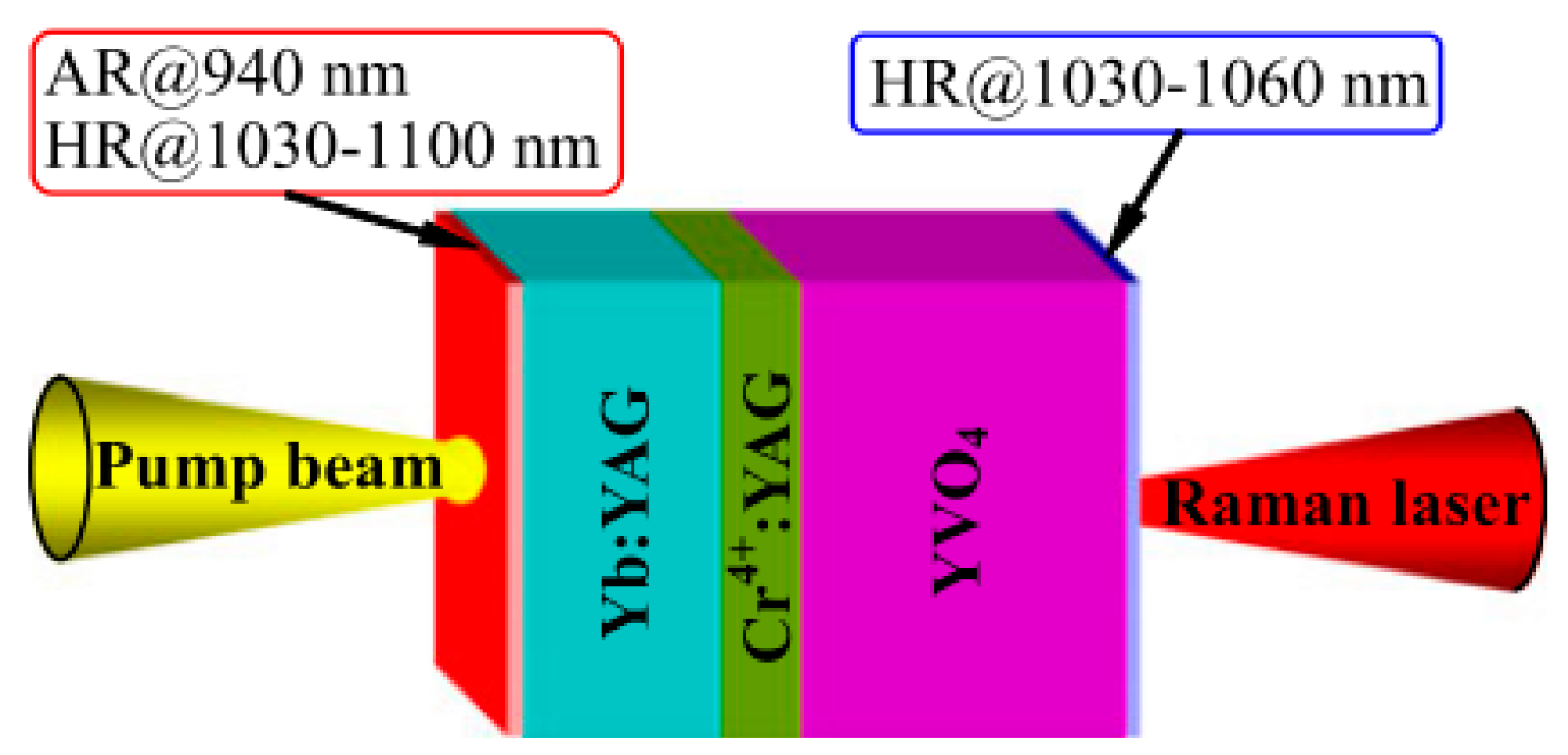
| Doped Ion | Time | Experimental Conditions | Output Characteristic | Refs. | ||
|---|---|---|---|---|---|---|
| Laser Crystal | Center Wavelength | Cr4+:YAG T0 | ||||
| Nd3+ | 2016 | Nd:YAG | 1112 nm | 95% | P = 11.2 kW, f = 9 kHz, FWHM = 27.2 ns | [107] |
| 2016 | Nd:YAG | - | 20% | P = 5.7 MW, f = 20 Hz, FWHM = 10 ns | [108] | |
| 2017 | Nd:YAG | 1.06 μm | - | P = 4.55 MW, FWHM = 552 ps | [109] * | |
| 2018 | Nd:YAG | 1064. 48 nm 1064.52 nm | 85% | P = 126.4 W, f = 5.8 kHz, FWHM = 42 ns P = 133.6 W, f = 5.8 kHz, FWHM = 40 ns | [110] | |
| 2019 | Nd:YAG | 1.05 μm | 87% 89% 94% 97% | P = 1.9 kW, FWHM = 24 ns P = 1.1 kW, FWHM = 34 ns P = 0.35 kW, FWHM = 51 ns P = 0.09 kW, FWHM = 88 ns | [111] | |
| 2019 | Nd:GdTaO4 | 1066 nm | 80% | P = 2.34 kW, f = 33.7 kHz, FWHM = 15.2 ns | [112] | |
| 2020 | Nd:YAG | 1074.1 nm | 89.5% | P = 1.6 kW, f = 21.7 kHz, FWHM = 23.7 ns | [113] | |
| Yb3+ | 2016 | Yb:Lu(WO4)2 | 1031 nm | 78% 83% | P = 80.3 kW, f = -, FWHM = 0.66 ns P = 69 kW, f = 12.4 kHz, FWHM = 0.69 ns | [114] |
| 2017 | Yb:LuPO4 | 1005 nm | 85.4% | P = 50.3 kW, f = 19.2 kHz, FWHM = 3.0 ns | [115] | |
| 2017 | Yb:KLu(WO4)2 | - | 85% 90% 95% | P = 480 W, f = 19 kHz, FWHM = 231 ns P = 190 W, f = 36.2 kHz, FWHM = 347 ns P = 110 W, f = 55.7 kHz, FWHM = 456 ns | [116] | |
| 2018 | Yb:LuVO4 | 1.02 μm | 99.3% | P = 209 W, f = 285.7 kHz, FWHM = 39.2 ns | [117] | |
| 2018 | Yb:KLu(WO4)2 | 1030 nm | 99.3% | P = 48.5 W, f = 970 kHz, FWHM = 39 ns | [118] | |
| 2019 | Yb:YAG | - | 85% | P = 67.5–90 kW, f = 1–20 kHz, FWHM = 3–4 ns | [119] | |
| 2020 | Yb:YAG | 1030 nm | 76% | P = 750 kW, f = 8.5 kHz, FWHM = 1.6 ns | [120] | |
Publisher’s Note: MDPI stays neutral with regard to jurisdictional claims in published maps and institutional affiliations. |
© 2021 by the authors. Licensee MDPI, Basel, Switzerland. This article is an open access article distributed under the terms and conditions of the Creative Commons Attribution (CC BY) license (http://creativecommons.org/licenses/by/4.0/).
Share and Cite
Tang, J.; Bai, Z.; Zhang, D.; Qi, Y.; Ding, J.; Wang, Y.; Lu, Z. Advances in All-Solid-State Passively Q-Switched Lasers Based on Cr4+:YAG Saturable Absorber. Photonics 2021, 8, 93. https://doi.org/10.3390/photonics8040093
Tang J, Bai Z, Zhang D, Qi Y, Ding J, Wang Y, Lu Z. Advances in All-Solid-State Passively Q-Switched Lasers Based on Cr4+:YAG Saturable Absorber. Photonics. 2021; 8(4):93. https://doi.org/10.3390/photonics8040093
Chicago/Turabian StyleTang, Jingling, Zhenxu Bai, Duo Zhang, Yaoyao Qi, Jie Ding, Yulei Wang, and Zhiwei Lu. 2021. "Advances in All-Solid-State Passively Q-Switched Lasers Based on Cr4+:YAG Saturable Absorber" Photonics 8, no. 4: 93. https://doi.org/10.3390/photonics8040093
APA StyleTang, J., Bai, Z., Zhang, D., Qi, Y., Ding, J., Wang, Y., & Lu, Z. (2021). Advances in All-Solid-State Passively Q-Switched Lasers Based on Cr4+:YAG Saturable Absorber. Photonics, 8(4), 93. https://doi.org/10.3390/photonics8040093






